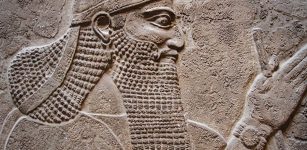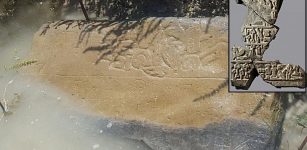Did A Universal Ancient Civilization Give Birth To All Other Cultures Across The World?
Ellen Lloyd - AncientPages.com - Despite our cultural, traditional, religious, and linguistic differences, humans are often alike. That is not surprising because we all belong to the same race.
When we study our ancient past, we find striking similarities between cultures separated by vast distances. Ancient people who were not supposed to have contacted each other constructed almost identical buildings used the same symbols, and relied on similar religious rites in their daily lives. There is no doubt prehistoric civilizations shared universal scientific and technological knowledge.
Are ruins of a universal ancient civilization submerged? Credit: Adobe Stock - Sven Bachstroem
Are these striking ancient similarities we encounter worldwide a result of a universal mind or rather a legacy of a universal ancient civilization that gave birth to all other ancient cultures worldwide? Was there once a global mother civilization that predated all ancestral civilizations?
Today, Mesopotamia is recognized as the cradle of civilization, but in recent years, some scholars have challenged this theory.
"More and more evidence confirms a very brave thesis, according to which the Balkan Peninsula, rather than ancient Mesopotamia that is the cradle of our civilization.
The evidence of a little-known culture preceding Egyptian and even Sumerian culture has been attracting the attention of researchers, turning everything we know about antiquity upside down.
Remains of this ancient society have gradually been emerging from the ashes of human history, taking us some 6-7 millennia back when a highly-advanced unknown civilization flourished in our lands. This period preceded Sumer and Akkad by at least one millennium." 1
It is true that around 8,000 years ago, people in Mesopotamia practiced agriculture and ancient Sumerians led the foundation of what is today defined as a civilization. We cannot dispute the fact that Mesopotamia changed the world. Still, we also cannot ignore that there are ancient underwater ruins that predate the Sumerian civilization. These structures testify to the existence of even older cultures on our planet.
As an example, we can mention Dwarka has long been considered a mythic place. However, the discovery of underwater ruin in the Gulf of Cambay has confirmed Dwarka did exist, and the vast city "is believed to predate the oldest known remains in the subcontinent by more than 5,000 years. Mainstream scientists maintain that ancient Indian culture/civilization goes back some 4-5 thousand years. Yet the ruins below the Gulf of Cambay go back at least 9 thousand years, i.e. to the time when the area submerged underwater.
This means that the city must have existed before the flooding, i.e., at least 9 thousand years ago." 2
We must also consider the fact that most of our oceans remain unexplored. This means we cannot dismiss the possibility that even older than 9,000 years can lie hidden in the waters awaiting our discovery.
Can remains of a universal prehistoric civilization be submerged? It is certainly possible. There are so many similarities between ancient civilizations that it is impossible to discuss them in this article, but we can mention a few examples.
"Most people think of Egypt when the word "pyramid" is mentioned. Although the Egyptian pyramids are today most well-known and keep attracting tourists, we must not forget that pyramids were built worldwide in ancient times. Research on connections between ancient people reveals that pyramids and dolmens were standard in different parts of the world.
Credit: MessageToEagle.com
Ancient dolmens are yet another great example of ancient universal thinking. The ancient traditions were the same despite the vast distance separating these cultures. Let us also keep in mind that the builders of the dolmens were unrelated to each other. Intriguing, isn't it?" 3
We find hand paintings depicted in rock art around the world and for some unknown reason, our ancestors carved the spiral symbol on countless rocks, sculptures, boulders, and ancient cave walls worldwide.
Credit: MessageToEagle.com
There are, of course, different opinions "as to how far these civilizations can be regarded as isolated and separate, but no doubt history reveals large-scale social unities with easily recognized cultural characteristics. Further, these unities exhibit periods of growth, maturity, and decline: this phenomenon seems universal, for it is found in the civilizations of Central America and in those of the old world. It is indeed an amazing panorama that history reveals; there can be no doubt about the general nature of the course of events, however, obscure the details may be. Civilizations go uphill and downhill with a certain inevitability." 4
Our ancestors on different continents had more in common than we previously thought.
Therefore, it is valid to ask whether this universal knowledge was a legacy of a long-gone mother culture whose people survived a catastrophe and created new civilizations worldwide.
Written by Ellen Lloyd - AncientPages.com
Updated on September 3, 2022
Copyright © AncientPages.com All rights reserved. This material may not be published, broadcast, rewritten or redistributed in whole or part without the express written permission of AncientPages.com
Expand for references- Ellen Lloyd - Thought-Provoking Theory Suggests Balkan Peninsula And Not Mesopotamia Was The Cradle Of Civilization, AncientPages.com
- A. Sutherland - Dwarka – Pre-Harappan City That Could Rewrite The History Of The World, AncientPages.com
- Ellen Lloyd - 10 Remarkable Similarities Between Ancient Civilizations, MessageToEagle.com
- Carr-Saunders, Alexander. "What Is A Civilization?" Theoria: A Journal of Social and Political Theory, no. 6 (1954): 9-15.
More From Ancient Pages
-
 Rare Iron- And Viking-Age Mortuary Houses Discovered In Norway
Archaeology | Aug 27, 2024
Rare Iron- And Viking-Age Mortuary Houses Discovered In Norway
Archaeology | Aug 27, 2024 -
 Mama Quilla – Incan Moon Goddess Of Marriage And Fertility Assisted By High Priestesses Of Qoricancha
Featured Stories | Jun 15, 2020
Mama Quilla – Incan Moon Goddess Of Marriage And Fertility Assisted By High Priestesses Of Qoricancha
Featured Stories | Jun 15, 2020 -
 Early Toilets Reveal Dysentery In Old Testament Jerusalem
Archaeology | May 26, 2023
Early Toilets Reveal Dysentery In Old Testament Jerusalem
Archaeology | May 26, 2023 -
 Who Was “Shimon”, Whose Name Appears On A 2,000-Year-old Hebrew Inscription?
Archaeology | May 20, 2023
Who Was “Shimon”, Whose Name Appears On A 2,000-Year-old Hebrew Inscription?
Archaeology | May 20, 2023 -
 Timboholm Great Golden Treasure Dated To Iron Age’s Great Migration Period
Artifacts | Oct 19, 2018
Timboholm Great Golden Treasure Dated To Iron Age’s Great Migration Period
Artifacts | Oct 19, 2018 -
 A Scarab Seal At Tel Gerisa, Depicts Walking Lion – Symbol Of Strength, Power And Authority
Archaeology | Sep 5, 2023
A Scarab Seal At Tel Gerisa, Depicts Walking Lion – Symbol Of Strength, Power And Authority
Archaeology | Sep 5, 2023 -
 Puzzling Sabaean Inscription Found On A Large Clay Jar Near The Jerusalem Temple Deciphered
Archaeology | Apr 4, 2023
Puzzling Sabaean Inscription Found On A Large Clay Jar Near The Jerusalem Temple Deciphered
Archaeology | Apr 4, 2023 -
 On This Day In History: Richard The Lionheart Ascended The British Throne – On July 6, 1189
News | Jul 6, 2016
On This Day In History: Richard The Lionheart Ascended The British Throne – On July 6, 1189
News | Jul 6, 2016 -
 Germany’s Stonehenge Pömmelte Reveals More Secrets – 140 Wooden Houses And 78 Silos Found
Archaeology | Jul 2, 2024
Germany’s Stonehenge Pömmelte Reveals More Secrets – 140 Wooden Houses And 78 Silos Found
Archaeology | Jul 2, 2024 -
 Evidence Of A 2,000-Year-Old Curry, The Oldest Ever Found In Southeast Asia
Featured Stories | Jul 25, 2023
Evidence Of A 2,000-Year-Old Curry, The Oldest Ever Found In Southeast Asia
Featured Stories | Jul 25, 2023 -
 11 Ancient Sacred Indian Symbols Explained
Ancient Symbols | Feb 19, 2017
11 Ancient Sacred Indian Symbols Explained
Ancient Symbols | Feb 19, 2017 -
 On This Day In History: Aviator Amelia Earhart Was The First Woman To Cross The Atlantic By Air – On June 18, 1928
News | Jun 18, 2016
On This Day In History: Aviator Amelia Earhart Was The First Woman To Cross The Atlantic By Air – On June 18, 1928
News | Jun 18, 2016 -
 Unexpected Discovery Of 600 B.C Assyrian Palace In Shrine Destroyed By Isil Militants
Archaeology | Mar 2, 2017
Unexpected Discovery Of 600 B.C Assyrian Palace In Shrine Destroyed By Isil Militants
Archaeology | Mar 2, 2017 -
 Just 7% Of Our DNA Is Unique To Modern Humans – We Are Not Much Different From The Neanderthals
Archaeology | Jul 27, 2021
Just 7% Of Our DNA Is Unique To Modern Humans – We Are Not Much Different From The Neanderthals
Archaeology | Jul 27, 2021 -
 Why Was Grette The Strong, Icelandic Poet And Warrior Afraid Of Darkness?
Featured Stories | Sep 30, 2023
Why Was Grette The Strong, Icelandic Poet And Warrior Afraid Of Darkness?
Featured Stories | Sep 30, 2023 -
 Lost City That May Have Defeated King Midas’ Kingdom Phrygia – Found Accidentally
Archaeology | Feb 23, 2020
Lost City That May Have Defeated King Midas’ Kingdom Phrygia – Found Accidentally
Archaeology | Feb 23, 2020 -
 Parthians: Their Great Empire And Skilled Horse Archers
Civilizations | Nov 10, 2016
Parthians: Their Great Empire And Skilled Horse Archers
Civilizations | Nov 10, 2016 -
 On This Day In History: Explorer Of The New World Amerigo Vespucci Born – On Mar 9, 1451
News | Mar 9, 2017
On This Day In History: Explorer Of The New World Amerigo Vespucci Born – On Mar 9, 1451
News | Mar 9, 2017 -
 Rare Gladiator Tombs Found In Ancient City Of Anavarza In Southern Turkey
Archaeology | Aug 16, 2022
Rare Gladiator Tombs Found In Ancient City Of Anavarza In Southern Turkey
Archaeology | Aug 16, 2022 -
 What Is The Codex Sinaiticus And What Does It Mean?
Ancient History Facts | Feb 5, 2019
What Is The Codex Sinaiticus And What Does It Mean?
Ancient History Facts | Feb 5, 2019




